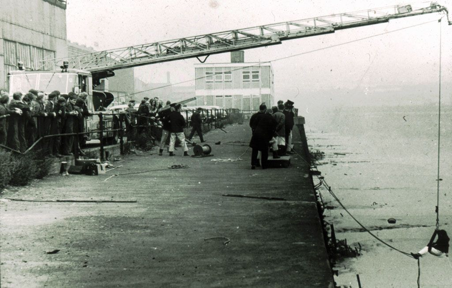pdf Gamma radiography source stolen and dumped in canal (1.35 MB)
Description of the incident
Discovery that the source was missing
A projection radiography container thought to contain a 60 GBq iridium-192 source was placed in a store with other radiography sources. The dose rate was monitored daily as part of a routine safety check. However, 34 days later, employees recognised that it was the depleted uranium shield of the container rather than the source that was producing the measured dose rate; the source was missing.
The regulatory authorities and the Police were informed. It was found that the end cap of the source pencil and the source capsule itself were missing.
Search for the source
The factory premises were searched. All drainage and sewer sump covers in the vicinity were removed and the sumps examined, but the source was not found.
The end cap of the source capsule was on a screw thread that required 12 turns to be removed. It was concluded that the removal of the source capsule was not accidental, but was deliberate. A number of local refuse sites were monitored as were the houses of staff who might have had access to the source or could have inadvertently picked it up.
Employees were interviewed and the seriousness of the loss of the source and the potential for significant exposures were impressed upon them. Three days after the loss was discovered, an anonymous telephone call alleged that the source had been taken for a radiography job that had ‘gone wrong’ and gave the location of a bridge from where the source had been thrown into a river that was 2 to 3 metres deep.
Recovery of the source
A special radiation detector, capable of operating under water, had to be constructed. The recovery operation lasted 2 days in very bad weather conditions. Initial attempts at dredging for the source were unsuccessful; it was eventually recovered by a Police diver using the underwater radiation detector and handling equipment.
The source was found to be sealed in a roughly cast lead disc 15 cm in diameter and 4 cm thick, wrapped in 3 mm lead sheet. Surface dose rates were up to 100 mSv/h. There was no evidence of contamination and the source was disposed of as radioactive waste.
Radiological consequences
Dosemeters worn by the Police divers recorded doses below 0.2 mSv.
The radiation doses received by the person(s) responsible for removing the source, covering it in molten lead (and presumably attempting to perform radiography) are unknown, but clearly there was a potential for significant exposure.
Lessons learned
Radiography employees should be made aware that depleted uranium gives rise to a gamma dose rate, and receive training to enable them to distinguish between a loaded and an empty container from the results of dose rate measurements.
While the safety and security of high activity sources is extremely important, it is always difficult to guard against malicious actions by source users themselves. It must, however, be ensured that efforts are made to promote a good safety culture within the organisation, and to highlight the dangers associated with the misuse (whether malicious or not) of high activity radioactive sources.
Plans for recovering sources (including orphan sources) from public areas need to be flexible enough to cover unusual circumstances, such as in this incident.

pdf Gamma radiography source stolen and dumped in canal (1.35 MB)



